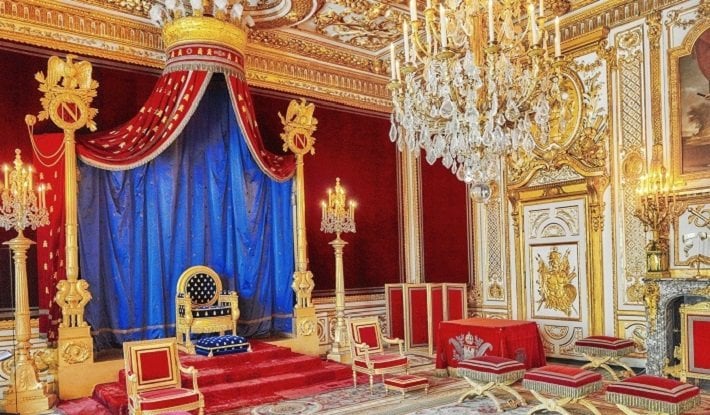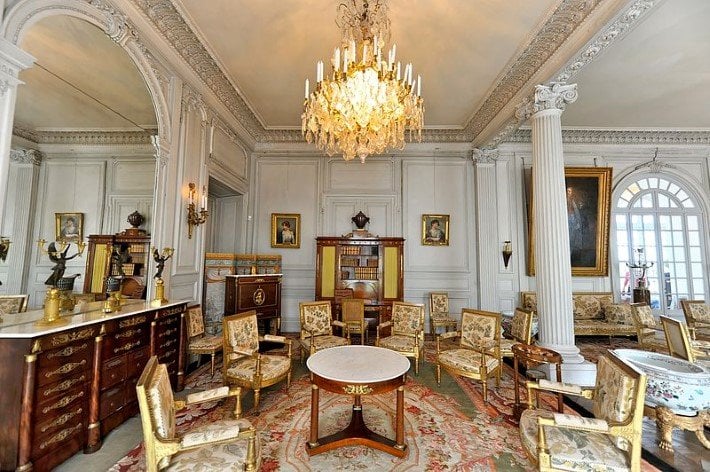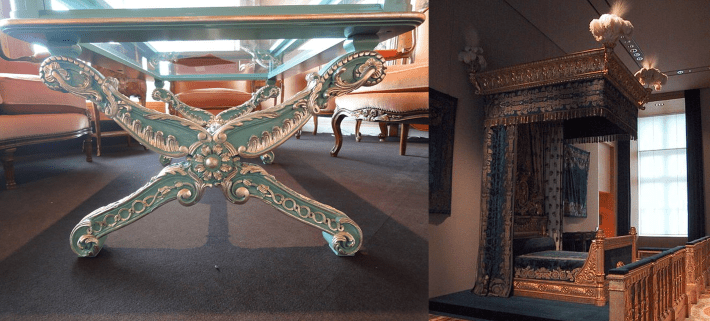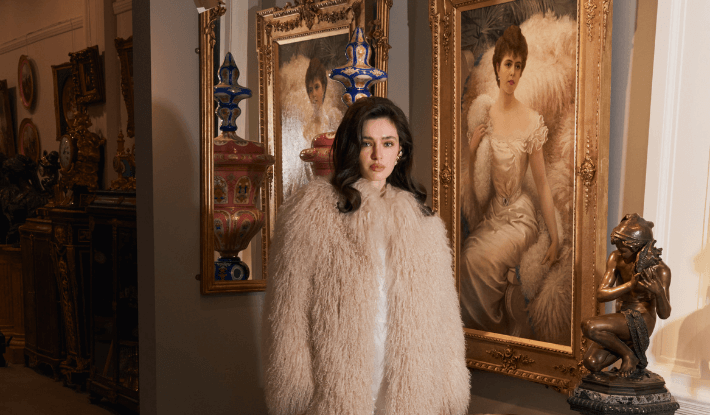The early 19th Century in France was a period that saw a huge deal of social and political change for the nation.
This unrest began in the wake of the French Revolution of 1792, which saw the ancient dynasty of French kings and queens terminated, with the public executions of the monarchy.
In the following sixty years, France was claimed by five different rulers, each with their own ideologies, each with their own legitimacy and importance to prove, and each seeking to leave a lasting legacy.
Despite the political turbulence throughout this age of revolution, the French and their rulers had another important legacy to uphold: their lasting reputation for fine furniture, excellent craftsmanship and exquisite design.
This blog post, the first in a two-part series, will consider the first half of the 19th Century, during which time furniture design became synonymous with the leaders themselves. So, just how did they achieve this, and what did furniture come to look like throughout the period? Read on to find out.
Napoleon I and the Age of Empire (1804-1815)
The 19th Century begins with the influence of Napoleon I, otherwise known as Napoleon Bonaparte, who was the first Emperor of France. He came into power in 1804 after twelve long years of political struggle which began with the 1792 French Revolution.
After King Louis XVI was executed as a result of the revolution, the interim period between monarchy and Napoleon I becoming Emperor, became known as the First Republic of France. During this time, Napoleon excelled in facing French enemies and making important alliances with other countries.
Napoleon’s successes in strengthening France as a national power saw him rise through the ranks, becoming the most powerful person in the country by 1800.
His power, influence and significance grew such that in 1804 he declared and crowned himself as the Emperor of France.
With both his military successes and his new status as Emperor, Napoleon was quick to underline important parallels between himself and the strong, highly revered Emperors of ancient Rome, who were great sources of inspiration for the French leader.
Portrait of Emperor Napoleon I of France by Jacques-Louis David, 1805. Via Wikimedia Commons.
What was the Empire style?
The Emperor Napoleon marked a new period of French history – never before had France been an Empire – and to underline and decorate this new epoch, came a new aesthetic rich in historic symbolism. This new aesthetic became known as the Empire style.
In the Empire style, which rose to the height of popularity between 1804-1815, Napoleon attempted to reincarnate the very essence of the ancient Empires and set himself within this rich and idealised history.
During this period, the Empire style dominated the decorative arts, interiors, furniture design, painting and architecture. It replaced the transitional ‘Directoire style’, which was the main design style in France from 1792-1804.
The Empire style lavishly revived and emulated Classical features and symbols, which derived from the ancient civilisations of Egypt, Greece and Rome, and were associated with sophistication, success and domination.
It was designed and intended to represent the Emperor Napoleon and the new French Empire as an idealised state, to appeal to the public, and underline Napoleon’s authority moving forward.
The Arc de Triomphe, Paris, constructed in 1806. The triumphal arch, commemorating battle success, is one of the most iconic revivals of Classical antiquity by Napoleon I. © Dietmar Rabich via Wikimedia Commons.
What were the key features of Empire Style furniture?
The Empire style was rich in loaded symbolism that overtly referenced the Roman Emperors of the Classical period, the Ancient Egyptians, the Greeks and the Etruscans, whilst linking them to the new Emperor Napoleon and his French Empire.
The Neoclassical period of the late 18th Century had already revived interest in the Classical dynasties, and Napoleon made use of this popularity by incorporating their most important characteristics and symbols in the furniture and decorations of the new Empire style.
In many ways, the Empire style also utilised many traditional French ideologies in its success, emulating the opulence, grandeur and luxury of the preceding Neoclassical, Rococo and Baroque styles of the Ancien Régime.
These combining factors made for impressive propaganda for Napoleon and his Empire.
Empire style furniture was predominantly derived from Greek and Roman forms. It was robust and broad in its proportions, championing symmetrical features, sharp corners and flat surfaces that were heavily decorated with important symbols.
Napoleon adopted his own motifs - the letter ‘N’ bordered by a laurel wreath, the eagle, the bee, and hieroglyphs - all of which became symbols of the new Empire. These motifs adorned furniture and decorative ornaments, which were rich in gilding, inlays and lacquerwork.
The Grand Salon at the Chateau Valencay, decorated with the robust shapes and classically influenced motifs of the Empire Style. © Gilles via Wikimedia Commons.
Napoleon’s wife, the Empress Joséphine, had a great love of swans, and they too came to be included in Empire furniture design, often incorporated into the design of chair and table legs or used as decorative features.
Upholstered furniture would feature bright, bold coloured fabrics offset by gold and intricate embroidery.
Another popular feature of the Empire style was the revival of chairs that referenced the Greek ‘Klismos’ chair, which featured tapered, curved legs that were bent to distribute weight.
Left: Napoleon’s throne, 1804. © P. Alejandro Diaz via Wikimedia Commons. Right: A replica of an Empire style stool with Klismos style legs in the shape of swans. © Allot rene via Wikimedia Commons
The Restauration period (1815-1830)
Whilst Napoleon’s powerful choice of aesthetic might have alluded to the idea that he was unshakeable as a leader, in 1815, following military defeat to the allied forces, he was forced to abdicate and the French Empire fell.
After some significant and turbulent struggles for power and control, the Bourbon monarchy was eventually restored from 1815; a period known as the Restauration (for the restoration of the Bourbon monarchy, not to be confused with the resoration of antique furniture!).
Marking the beginning of the Restauration, Louis XVIII came into power as King of France. Following his death in 1824, he was succeeded by his brother, Charles X. And, of course, under these two kings, the style of furniture design and the decorative arts changed yet again.
However, unlike the Emperor Napoleon, who had a flush bank account to commission lots of new furniture, by 1815 the Royal purse did not afford for a great deal of immediate changes.
Commissioning an entire house of personalised furnishings was an expensive affair. The newly restored Kings had to make do with budgeted changes, and this did not allow for a distinctive style to develop.
However, during the Restauration period, it was essential that all symbols of Napoleon I were eliminated, but many Empire style features remained and many features of the 18th Century monarchy were gradually revived.
What resulted was that, in terms of a decorative style, the Restauration period knew what it wasn't but it didn't entirely specify what it actually was.
Left: Klismos style table which had been made popular during the Empire, but not that during the Restauration period they were made without Napoleonic regalia. © Allot rene via Wikimedia Commons. Right: Charles X’s bed in the Restauration style. Note the similarity between the décor of the bed and the décor of Napoleon’s throne! © Zubro via Wikimedia Commons.
However, subtle differences were gradually made to furniture design during this period – forms and shapes, which had been square and robust, were softened and lightened in favour of incorporating gentle curves.
Swans remained as an important motif, and the Restauration period saw a return of the acanthus leaves and lions legs that were popular under the kings of the 18th Century.
Charles X was far more self-important as a ruler than Louis XVIII, and consequently became exceedingly unpopular as he tried to rule as an absolutist king which had been the cause of the 1792 revolution.
After a struggle for power known as the 1830 July Revolution, Charles X was forced to abdicate and Louis-Philippe was crowned ‘King of the French’ and ruled for the people, rather than being divinely granted power.
King Louis-Philippe (1830-1848)
Whilst France once again had a King on the throne, Louis-Philippe made more liberal reforms to France, which considered the liberal politics favoured by the growing middle class, known as the bourgeoisie.
Portrait of King Louis Philippe of the French, 1839, by Franz xavier Winterhalter. © via Wikimedia Commons.
However, during the period between 1815 and 1830, it was important to shake off the mark that Napoleon had left on France and restore a new, kingly power that appealed to the people. In short – and in terms of furniture and the decorative arts – the Restauration style had to change, and the Empire style had to go completely.
The style that prevailed following the restoration truly gained momentum after 1830 and became known as Louis-Philippe style, or ‘restauration’.
What was the Louis Philippe style?
The Louis-Philippe style was a movement named for the monarch that flourished predominantly in furniture design and across the decorative arts between 1830 and 1848.
The Louis-Philippe style had to straddle a delicate balance between regalia, ceremonial importance and a certain sensitivity that did not appear to promote any kind of grossly excessive spending.
This sensitivity was unique to Louis-Philippe as King of the French, and it was necessary for any of his successes.
Surrounded by constant reminders of the 1792 Revolution and the execution of Louis XVI, not to mention the forced abdication of his predecessor, Charles X, Louis-Philippe had to be careful not to provoke the public into further revolts which would put his position as king into jeopardy.
However, perhaps the most important feature of the Louis-Philippe style was that it represented a new, fresh style for a different kind of monarchy. Where the previous Empire Style had served as propaganda for the glorification of Napoleon I, the Louis-Philippe style aimed for sombre elegance and simple yet bold sophistication.
The Louis-Philippe style attempted to visually communicate the power of the Bourbon monarchy as responsible leaders, worthy of being in place on the throne.
What did furniture under King Louis-Philippe look like?
The Louis-Philippe style faced the challenge of conveying majesty and power through furniture and the decorative arts, yet remaining earnest and dignified.
For this reason, it was the first decorative style in France that rejected flamboyance in favour of controlled, linear geometry for furniture.
Rather than the light, bright-toned exotic woods that had previously been used, dark woods such as walnut, mahogany and rosewood became popular for furniture and construction. The heavy use of gilding that had been popular since the 17th Century became more refined and sparingly used.
Pieces in the Louis Philippe style were created from large, bold shapes with broad, sweeping proportions and simple, unfettered ornamentation.
Cabinet, or 'armoire', in the Louis Philippe style, Louvre Museum. Note the use of dark, contrasting wood without gilding. © Loicwood via Wikimedia Commons
One of the most iconic pieces of furniture in the style is the sleigh bed, which features a high, sweeping headboard and curved footboard. The French term for this is ‘lit bateau’, which references the similarity of this type of bed to a boat.
The bedroom of Madame Recamier at the House of Chateaubriand, featuring a 'lit bateau' and Louis-Philippe style wooden furniture. © FLLL via Wikimedia Commons.
The result of the overall aesthetic was stately, regal grandeur that was sombre and well-measured, appealing and affordable for the growing bourgeoisie and the King alike.
To be continued...
Louis-Philippe might have tentatively held power for eighteen years, but the age of revolution in France was not yet over. The Revolution of 1848 overthrew Louis-Philippe and the monarchy for the final time. This had major consequences for France and, of course, its decorative arts and furniture.
The first half of the 19th Century presents a truly diverse - and politically turbulent - history of furniture design: Napoleon I invites us to share his reverence of the Classical and speaks volumes of his own self-importance, whereas Louis-Philippe invites us to appreciate his elegant, understated decorations and refined style as monarch
So what happened next, after Louis-Philippe? Would France finally have some much-needed stability? Would furniture design settle? Our next blog post will consider the late 19th Century and continue the story.
Until next time!















